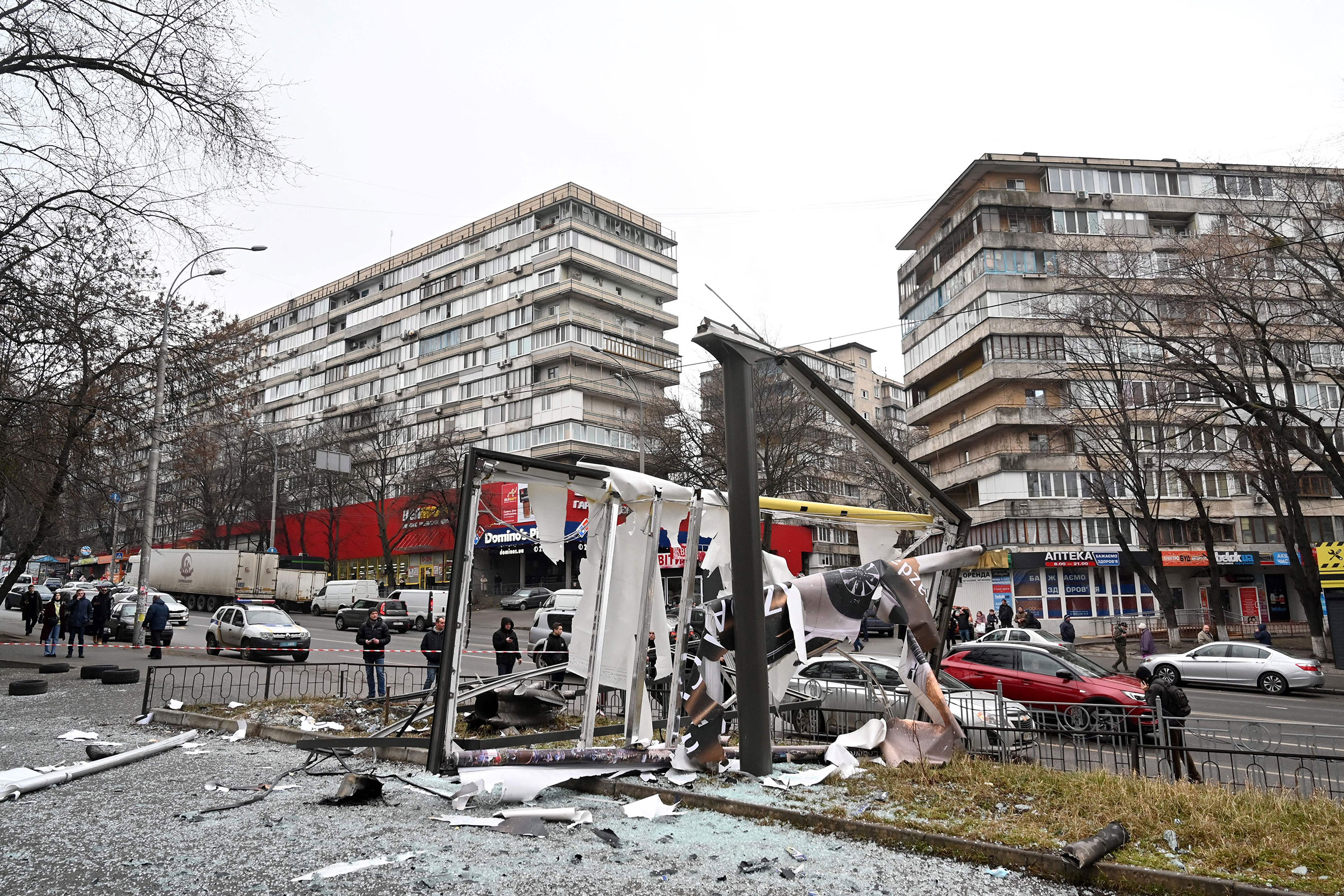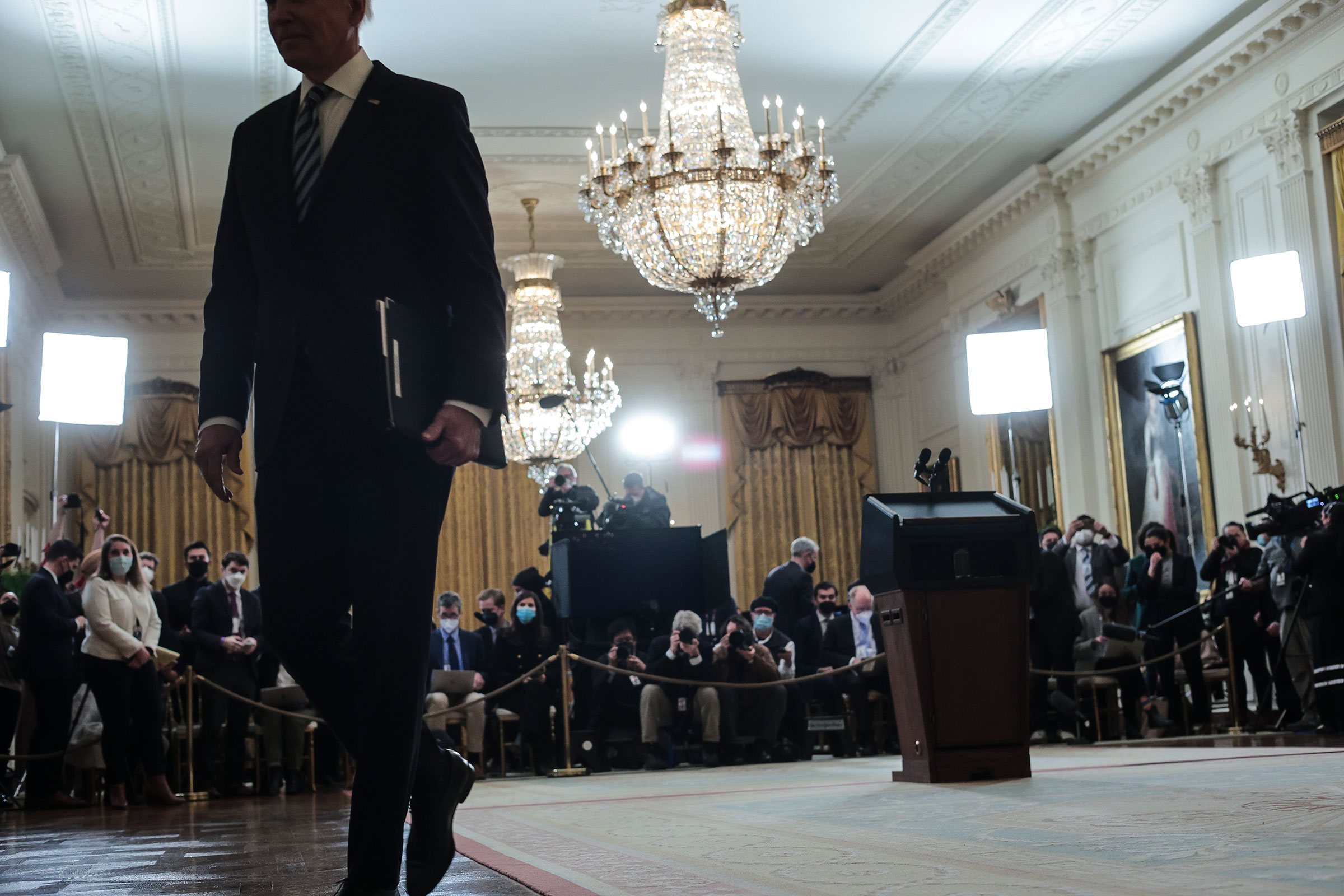The Russian military’s aerial offensive in Ukraine will pave the way for a grinding ground invasion expected to attempt to overthrow the government in Kyiv, according to a senior U.S. defense official who spoke on condition of anonymity to discuss sensitive matters.
“It’s our assessment that they have every intention of decapitating the government and installing their own method of governance, which would explain these early moves towards Kyiv,” the U.S. official says.
Russian President Vladimir Putin’s sweeping offensive has drawn worldwide condemnation, sunk global stocks and pushed Europe and the world to the cusp of a wider war. The bombardment came after months of diplomatic efforts to dissuade Russia from moving ahead with military action. “The Russian military has begun a brutal assault on Ukraine without provocation, without justification, without necessity,” President Joe Biden said Thursday at the White House. “This is a premeditated attack.”
In response, Biden announced tougher sanctions on Russia and the deployment of 7,000 troops to Germany. The deployment, which includes an Army armored brigade combat team, is part of a realignment of American firepower in Europe to deter Putin. Biden has insisted U.S. troops will not fight in Ukraine, but he has redoubled defenses in surrounding countries by moving roughly 14,000 troops eastward on the continent in the past three weeks, along with naval ships and warplanes in response to the current crisis.
While Ukraine is not a member of the North Atlantic Treaty Organization (NATO), it borders four member nations—countries that Biden has pledged to protect at all costs. “The United States will defend every inch of NATO territory with the full force of American power,” he said. “This is a dangerous moment for Europe.”

Read More: Here’s What We Know So Far About Russia’s Assault on Ukraine
Waves of 75 Russian aircraft pierced Ukraine air defenses in an hours-long assault on population centers that began in the pre-dawn darkness, while lethal salvos of more than 160 missiles came from ground batteries and naval ships in the Black Sea, according to the senior U.S. defense official. Targets included military barracks, ammunition warehouses and nearly 10 airfields throughout the country.
Russian forces stormed into Ukraine along three main axes: south from Belarus, west from Russia and north from the Black Sea peninsula of Crimea in southern Ukraine, which Russia illegally seized in 2014. Ukrainian authorities said Russia had seized the Chernobyl nuclear power plant, site of the world’s worst nuclear disaster in 1986, but U.S. officials could not confirm what that meant.
The heaviest fighting is taking place in and around the eastern city of Kharkiv, the senior U.S. official says, where Russian forces have launched an air assault. Ukraine’s President Volodymyr Zelensky said Thursday that 137 Ukrainians have been reported killed as a result of the Russian invasion, with more than 300 wounded. But the full-scale invasion of a sovereign nation by a hostile nuclear power left U.S. officials scrambling to tally the destruction Russia has wrought. “We do not have a good sense of total damage,” the official says. “We do not have a good sense of casualties.”
With airports under attack, small numbers of people fleeing the violence have started streaming over the nation’s borders, the official said. U.S. paratroopers positioned in Poland have been told of the potential to see tens of thousands of refugees. “

Read More: ‘There Is No Purgatory for War Criminals.’ World Condemns Russian Invasion of Ukraine
While the Russians have launched sporadic cyberattacks on Ukrainian government websites, the U.S. has yet to see the anticipated electromagnetic assaults that Russia could use to jam communications and satellite signals. “We don’t believe that the full scope of Russian electronic warfare capabilities have come into play,” the U.S. official says. “And they may yet.”
In his statement announcing the invasion Thursday, Putin warned against any efforts to deter Moscow’s forces. Some interpreted his bellicose speech as alluding to the possibility of using nuclear weapons. “Anyone who tries to interfere with us, or even more so, to create threats for our country and our people, must know that Russia’s response will be immediate and will lead you to such consequences as you have never before experienced in your history,” Putin said. “We are ready for any turn of events.”
It was a stark shift from the sober, almost mournful restraint that has characterized U.S. and Russian leadership’s comments on the use of the world’s most powerful weapons since the end of World War II. Putin’s comments drew the attention of the White House and the Pentagon as American officials watched the Russian assault in real-time.
“We haven’t seen a conventional move like this, nation-state to nation-state, since World War II—certainly nothing on this size and scope and scale,” the senior U.S. official says. “If it unfolds the way we have come to believe that it will, it has every potential to be very bloody, very costly and very impactful on European security writ large, perhaps for a long, long time to come.”
More Must-Reads from TIME
- Why Trump’s Message Worked on Latino Men
- What Trump’s Win Could Mean for Housing
- The 100 Must-Read Books of 2024
- Sleep Doctors Share the 1 Tip That’s Changed Their Lives
- Column: Let’s Bring Back Romance
- What It’s Like to Have Long COVID As a Kid
- FX’s Say Nothing Is the Must-Watch Political Thriller of 2024
- Merle Bombardieri Is Helping People Make the Baby Decision
Write to W.J. Hennigan at william.hennigan@time.com